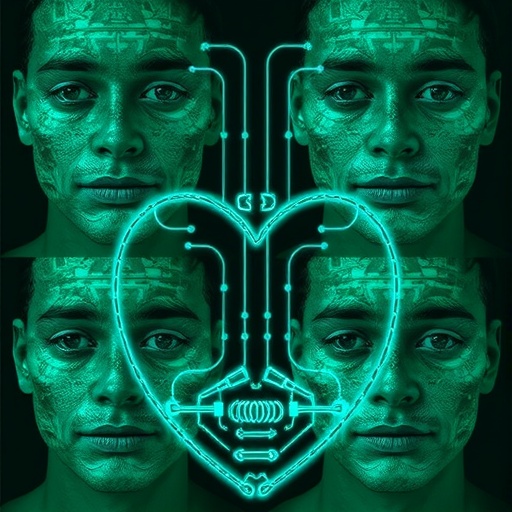In an era when technology increasingly permeates every facet of our lives, the understanding of human emotions has become a focal point of research, particularly in artificial intelligence (AI) and machine learning. The recent work by Zheng and Huang presents an innovative approach that melds music, emotion, and technology through a groundbreaking system called LyricEmotionNet. This novel architecture aims not only to recognize emotions robustly but also to add a multidimensional perspective to how AI comprehends emotional contexts taken from song lyrics.
The researchers have ingeniously combined hybrid modeling concepts—CapsNet (Capsule Networks) with memory network architectures—creating a framework that transcends traditional emotion recognition methodologies. By effectively bridging the gap between textual analysis and emotional recognition, this model offers unprecedented accuracy and reliability in detecting emotional sentiments conveyed through lyrics. This development holds the potential to reshape how AI interacts with the subtleties of human feelings embedded in cultural artifacts like music.
At its core, LyricEmotionNet operates on the principle that song lyrics are more than mere words; they encapsulate a wide spectrum of emotions, narratives, and experiences. Zheng and Huang’s model analyzes the lyrical content to decode emotional signals, developing a nuanced understanding of the richness inherent in song lyrics. Utilizing advanced natural language processing techniques, the AI is capable of recognizing not only direct expressions of emotion but also more subtle, nuanced sentiments that may be conveyed through metaphorical language or context-specific references.
The capsule network architecture inherent in LyricEmotionNet allows the model to maintain spatial hierarchies between information clusters. This is essential in emotion detection, as many expressions are not straightforward but rather depend on the contextual layering within a lyric. By prioritizing relationships between words and sentiments, CapsNet enhances the model’s understanding of emotional clusters, thereby increasing the likelihood of accurate emotion attribution. In essence, this structure mimics the human cognitive process of interpreting emotions through both linguistic and contextual cues.
Memory networks augment this process further by retaining contextual understanding over a longer duration, allowing the model to build a cohesive narrative from the lyrics. This memory aspect is critical, as emotional responses are often constructed over time, shaped by sequences of ideas rather than isolated statements. By leveraging a hybrid CapsNet-memory network approach, Zheng and Huang carve out a new frontier in AI emotion recognition, particularly within the domain of music.
The implications of this research extend beyond mere academic interest; they have vital applications in various industries, particularly in music streaming services, where understanding listeners’ emotional states can translate into personalized experiences. By recognizing the emotional content of songs that users engage with, streaming platforms can better curate playlists, enhancing user satisfaction and engagement. Moreover, the potential use of this emotional recognition system in therapeutic settings, such as music therapy, could provide invaluable insights for professionals working with clients seeking emotional healing through music.
Zheng and Huang’s innovative model enhances the existing landscape of emotion recognition technology, previously dominated by less sophisticated models. Existing systems often rely on surface-level keyword analysis or extensive training datasets which may not capture the emotional depth of more complex texts. The LyricEmotionNet systematically overcomes these limitations by employing a sophisticated architecture designed to perceive emotions as multidimensional constructs, offering a more discerning view of lyrical content.
The research conducted by Zheng and Huang represents a paradigm shift in the capabilities of AI concerning emotional intelligence. As discussions around ethical AI models grow louder, the ability of a system to detect and respond sensitively to human emotions becomes integral. This technology may catalyze further advancements in sectors such as education, customer relations, and mental health, where understanding and responding appropriately to human emotions could enhance overall efficacy and connection.
The LyricEmotionNet framework embodies the forward momentum of AI towards greater empathy and understanding, emphasizing the importance of not only perceiving emotions but also interpreting them with finesse. This research could open doors towards AI systems that are more attuned to human experiences, potentially leading us toward more harmonious interactions between humans and machines in our daily lives.
In conclusion, Zheng and Huang’s LyricEmotionNet marks an important milestone not merely in AI development but also in the understanding of human emotional expression. Through their hybrid CapsNet-memory architecture, they have taken a significant step towards an AI capable of grasping the complex tapestry of emotions we convey through music. This advancement presents a thrilling glimpse into the future of AI, where emotional intelligence meets technological innovation, promising richer applications in various facets of society.
As we look forward to the impacts of this groundbreaking research, it becomes clear that the evolution of human-computer interaction is set to become profoundly more intricate and meaningful. Zheng and Huang’s work underscores a vital truth in AI development: that at the intersection of technology and emotion, we can find not just new tools for analysis but a bridge toward greater understanding among all forms of intelligent beings.
Subject of Research: Emotion Recognition in AI using lyrical analysis
Article Title: LyricEmotionNet for robust emotion recognition with hybrid CapsNet-memory network architecture
Article References:
Zheng, G., Huang, J. LyricEmotionNet for robust emotion recognition with hybrid CapsNet-memory network architecture.Sci Rep 15, 37785 (2025). https://doi.org/10.1038/s41598-025-21593-3
Image Credits: AI Generated
DOI: 10.1038/s41598-025-21593-3
Keywords: Emotion Recognition, Lyric Analysis, CapsNet, Memory Network, AI, Natural Language Processing.
Tags: advanced AI emotional intelligenceCapsule Networks in machine learningcultural artifacts and technologyemotion recognition in AIhuman emotions and machine learninghybrid CapsNet memory architectureinnovative approaches in emotional AILyricEmotionNet systemmultidimensional emotion understandingmusic and emotion analysissong lyrics sentiment analysistext-based emotional detection





